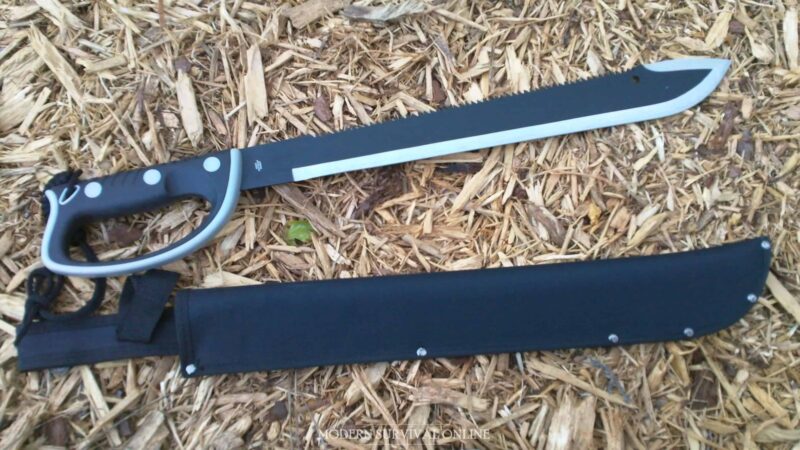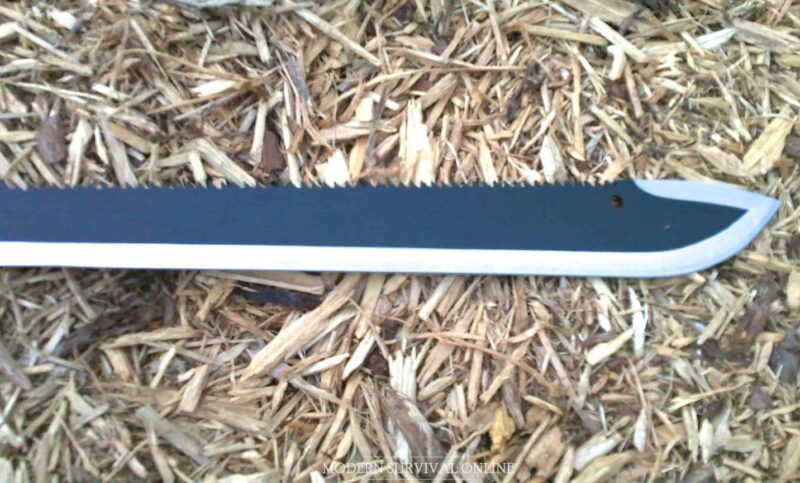Choosing a blade for survival is serious business for preppers. In one form or another, a bladed tool is going to be one of the most used and most important that you will have with you when the chips are down. It will be used for shelter creation, and a multitude of other tasks. Two of the most popular options are the classic survival knife and machete.
Which is best between a machete and a survival knife? The survival knife is the all-around choice, being generally competent at most tasks, more adaptable, and still serviceable for processing wood when used with a baton. Machetes excel at chopping and hacking, making them perfect tools for lemming branches and clearing brush, and also afford more reach in a close combat situation – but are less adaptable than knives.
As always, the context in which the tool is used and your requirements are going to dictate the piece of gear that is right for you. In the rest of this article we will make a case for, and also against, each of these tools depending on what you need.
Basic Survival Tasks for a Blade
In most survival situations the tasks required of your bladed tool tend to look pretty similar across the spectrum of potential events.
In a woodland or other natural setting, you’ll rely on your blade to chop or otherwise process all kinds of natural materials, from wooden branches and logs to live plants like vines and creepers.
In an urban setting you’ll often use a blade and improvised crafting, utilitarian tasks and self-defense.
And of course some chores are universal. You might only need your knife or other blade for a little whittling, to cut paracord, strike on a ferro rod, or just help you fish something quickly out of burning coals.
The bottom line is that some tasks call for significant power and brute force, where others call for a deft and delicate touch. There is no universally right answer to most of these questions; instead, everything is a trade-off.
There are times you’ll have a survival knife where you wish you had a machete, and plenty of times where you will have a machete and pine for a survival knife.
Carrying both is always an option, but most preppers will not want to commit to the weight and additional bulk unless they can truly justify taking both along. Those situations will be few and far between.
Pros and Cons: Survival Knife and Machete Compared
| Attribute | Survival Knife | Machete |
| Versatility | Excellent | Limited |
| Chopping | Fair; if used with baton | Excellent |
| Weight | Light and handy | Light, but length can be a problem |
| Precision | Good for detail tasks | Clumsy for detail work |
| Defense | Fair; can be used as spear | Good; potent slasher with reach |
Survival Knife
The survival knife is the constant, venerable choice of most preppers and outdoorsman. A good field, or bushcraft, knife can handle the overwhelming majority of jobs you might ask of it, even in the middle of a survival situation
Keep in mind that serious brute force tasks will require you to be creative and use the knife in tandem with another tool that you’ll have to salvage or fashion.
Your survival life is going to be just as capable of shaving twigs and bark for tinder as it is for notching out wood pieces to help you construct a trap such as a snare.
You can cut cord with it. You can cut your food with it. You can skin game with it. And you can even process your firewood with it if the wood is soft or you want to baton through it using a sturdy branch or some other soft club to help it along.
Any good knife is a formidable weapon in a close combat situation, and a survival knife is no exception. But it does give up reach, only barely extending yours compared to going empty handed.
Luckily, with some suitable cordage and a working knowledge of knots and lashings a survival knife can be paired with a strong, straight branch or pole to make a primitive but deadly spear.
The survival knife’s biggest shortcomings are any situation that calls for a considerable amount of power. You’ll only be able to effectively hack and slash your way through comparatively soft, thin twigs and branches or vines, and even then your knife had better be plenty sharp.
As mentioned above, it is true that you can creatively employ a survival knife for heavy duty tasks it is not otherwise suited for, but this will prove to be very hard on your knife, even a good one.
In the end, the survival knife is a superb all around choice, and one that is highly adaptable to all kinds of survival situations and the definite choice for delicate detail work.

Machete
The machete is the obvious choice when chopping, clearing and limbing are your primary concern. If you need to process firewood, the tough, flexible blade of the machete as well as its greater length is going to help it do a far better job used with or without a baton.
Machetes are perennial tools in any biome where plant life is abundant, grows thick and must be pruned back to make any progress through it at all. It excels at sailing through small diameter woods and tough, fibrous vines and creepers alike.
If heavy duty work is going to make up a large percentage of your survival tasks, you’ll be well served by the machete.
The machete also excels in most self-defense situations, combining excellent chopping and slashing capability with greater length than a comparable survival knife which will help keep you safely out of an attacker’s reach while generate power.
Only in a tangled up grappling encounter will the machete falter compared to a survival knife.

But while the machete excels at hard use, brute force tasks it falters greatly when the time comes to use precision.
The machete is a poor choice for delicate notching, stripping and shaving, and though it is more than capable of cutting all kinds of cordage its greater length makes it clumsy for close-in chores.
The machete is also less versatile than the survival knife. It is not as handy, not as agile, and cannot be combined with a branch or other half to make a good serviceable spear as most machetes are edge centric tools, not point centric.
The Overall Winner
For the vast majority of preppers facing the vast majority of situations they would be best served by having a large fixed blade knife instead of a machete. A machete gives up quite a bit of versatility in exchange for its singular excellence at slashing and chopping.
The versatility of the survival knife and its general competency at so many various tasks is what makes it a supreme tool for emergencies.
Unless I was in extremely dense terrain with tons of vegetation I’ll take a survival knife, though I would still feel pretty confident about my chances if all I had was a machete.
Conclusion
Both survival knives and machetes are valid tools for surviving uncertain situations and emergencies or all you can depend on is your wits and what you have with you.
That being said, the versatility and adaptability of the survival knife makes it the ideal choice for dealing with the unknown.
Though the machete has far greater efficacy and power for chopping and limbing, it will struggle and become cumbersome for the many delicate, up close tasks that you’ll need to complete.

Like what you read?
Then you're gonna love my free PDF, 20 common survival items, 20 uncommon survival uses for each. That's 400 total uses for these dirt-cheap little items!
We will not spam you.
Just my opinion but most of the precision work you would need to do would be better suited to a pocket knife which should be an EDC for most people. As for using your survival knife as a spear point this would take a valuable tool and both turn it into a one trick pony and put it in greater jeopardy of being lost or broken. You can make a spear by simply cutting a good point on the end of the limb you are going to use and harden it in a fire. Spears and arrows were both used a long time before we had metal blades to put on them. Batoning wood again puts a very useful tool at risk if it is damaged and all you have as a cutting instrument you are in deep trouble
My opinion carry the machete
I fully agree with Poorman. This article is basically pitting apples against oranges for no good reason. The survival knife and machete have their purposes and both excel at what they were made for. When I’m out in the bush I carry an Ontario Battle knife as a survival blade, a 12″ machete, AND a folding pocket knife. Nothing less will do.
Actually there is a good reason for it: this is a common question many people have. We wrote this article to help them figure out the differences. And I think Tim did a wonderful job at explaining them.
I liked the article. I, however, would carry both. A machete is light. A bushcraft-style knife, such as a Mora, is light. Together they weigh about the same as some larger survival knives. A lot of this depends on where you are, where you’re going, for how long. Don’t need a machete in the desert, or at sea. In the jungle, a machete and an Opinel will do just fine. Where I am, in Florida, you kind of need both bushcraft knife and machete. I would even go a step further and carry a multi-tool as well. I really like the added advantage of having an awl, small saw, file, pliers, etc. I can cut weight elsewhere, such as cold weather gear, since we have very little of that. I would only have to carry a good tarp for sunshade and rain cover. Local environment will dictate the need, or lack thereof.